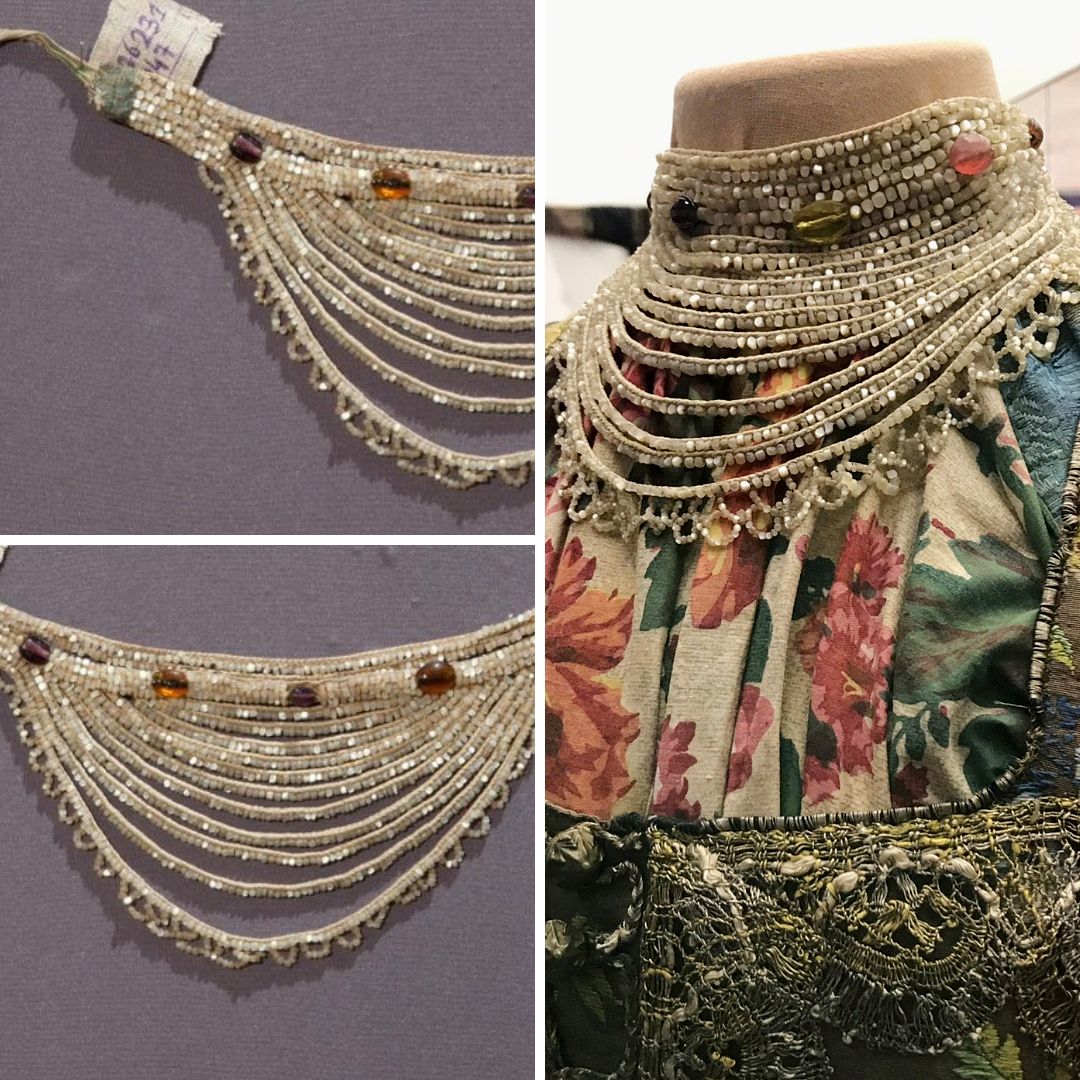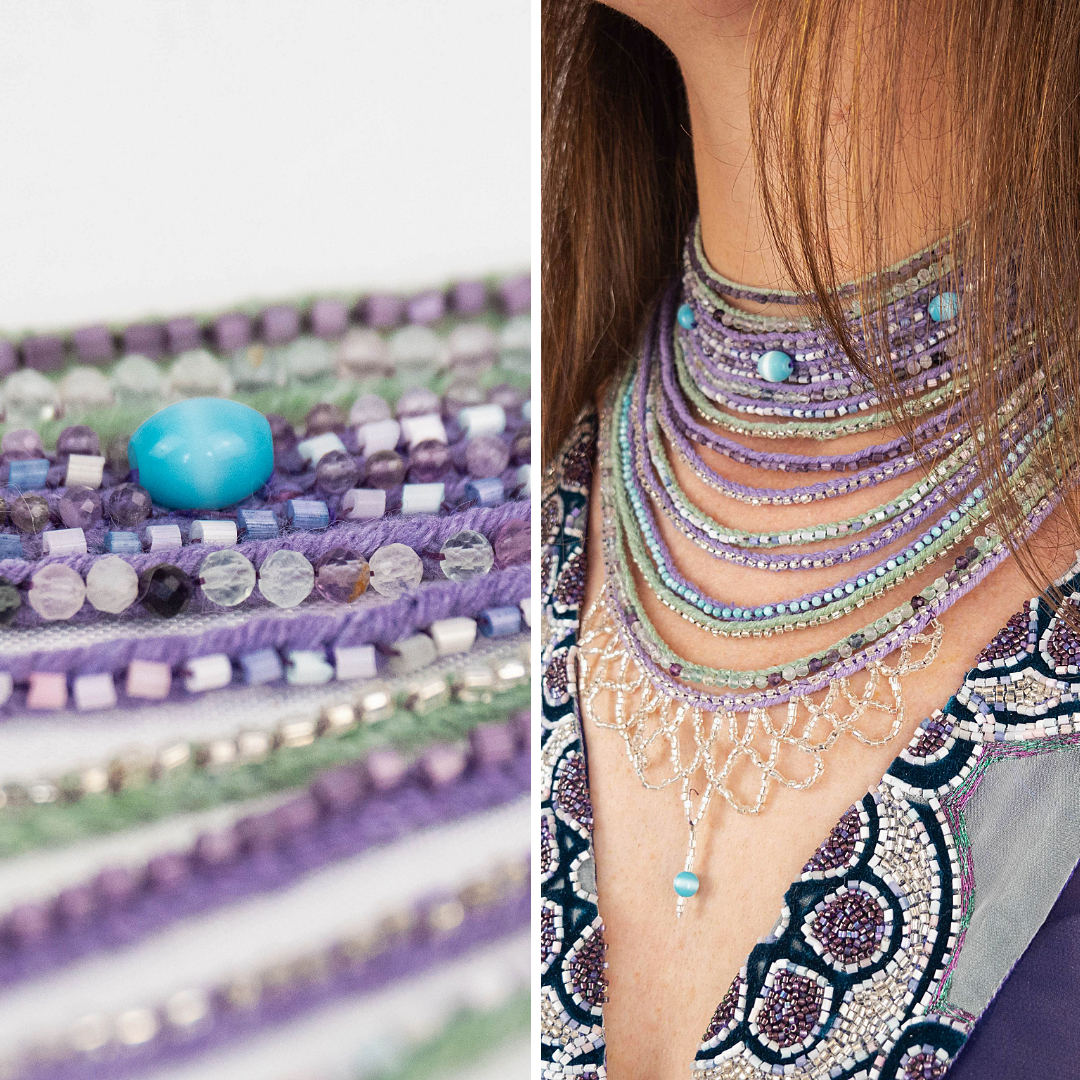Ozherelok: Multi-Strand Necklace in Russian Folk Costume
New to Luneville embroidery?
Start with the chain stitch—my free visual guide shows you exactly how
The ozherelok (ожерелок) is a type of textile necklace from Northern Russia, known for its distinctive structure of braided cords and decorative beads. While almost unknown outside Russian-language sources, this form of jewelry held a key place in festive and ceremonial dress.
Historical examples preserved in museum collections date from the late 18th to early 20th century, though the form itself likely predates this. Unlike metal jewelry, the ozherelok was made entirely of textile and beads — crafted using materials and techniques tied to regional craft traditions. This article introduces the ozherelok, explains how it was made, and outlines its place in historical costume culture.
What Is an Ozherelok?

The ozherelok is a type of necklace made from multiple strands of braided cotton or linen cord, decorated primarily with beads. It typically follows one of two structural formats:
A horizontal panel of cords sewn together to form a flat base, often decorated with large beads. This panel was paired with free-hanging strands of various lengths that hung below it.
A composition made entirely of free-hanging strands, each decorated individually with beads.
In both types, the strands were joined at each end and tied around the neck using a ribbon, forming a complete necklace. The resulting piece often covered the upper chest, with beads serving as the main decorative element. Materials included glass beads, mother-of-pearl, imitation pearls, metal beads, and occasionally natural materials like amber or coral.
The visual logic was deliberate: strands were often arranged with attention to even spacing and mirrored decoration, creating a layered, symmetrical composition across the chest.
Construction and Materials

The base of the ozherelok consisted of hand-braided cords, most commonly made from cotton or linen threads. In panel-type necklaces, these cords were sewn together in horizontal rows to form a stable textile base that could hold heavier decorative elements. The loose strands — either used on their own or in addition to the panel — were similarly beaded and cut to different lengths, adding variation in form and movement.
All strands were gathered and secured at both ends, and the entire piece was worn with a ribbon tie at the back of the neck. This practical fastening allowed flexibility in size and helped the necklace conform to different garment styles.
The beads themselves were highly variable depending on availability and social status. Some families used purchased glass beads, while others incorporated repurposed buttons, imitation pearls, or locally sourced decorative elements. In wealthier households,ozherelok could include coral, amber, or fine mother-of-pearl, whereas more modest examples made creative use of metal buttons and trade beads. In some cases, beads were passed down across generations or brought back from markets and fairs by traveling family members.
Cultural Role
The ozherelok was worn primarily by young women and brides in the Russian North as part of festive and ceremonial costume. It was a highly visible piece of adornment, often worn with other elements such as embroidered collars, decorative headwear, and layered garments. As part of a larger ensemble, the ozherelok functioned not just as jewelry but as a marker of social role, occasion, and community identity.
Its construction reflected both aesthetic and social considerations. In some regions, the ozherelok was made specially for a wedding or coming-of-age event. In others, it formed part of a woman’s regular festive attire. Materials were chosen with care, sometimes reflecting the family's status or ability to trade for finer goods.
The object also carried personal meaning. Some women reused beads from their mothers' or grandmothers' necklaces; others used elements brought home by relatives working outside the village. These layers of history were embedded in the necklace’s structure, making it a form of family heritage as well as personal expression.
Disappearance and Revival
Due to massive cultural and social shifts across Russia in the early 20th century, the ozherelok gradually disappeared from everyday wear. Although the practice of wearing full folk costume continued in some ceremonial contexts, necklaces of this kind were no longer part of everyday life.
In the 1970s and 1980s, however, ozherelki were sometimes revived as part of stylised wedding costumes used in folk performances and community events. These reconstructions — often made with synthetic ribbons and plastic beads — retained the layered, beaded logic of historical examples.
The ozherelok offers more than a glimpse into historical Russian fashion — it reflects a self-sufficient, craft-based approach to ornamentation rooted in textile techniques.
Its clear construction, visual rhythm, and material logic make it more than a relic of the past. For designers and makers today, the ozherelok presents a viable model of how textile-based jewelry can exist on its own terms —without imitating fine metals or relying on traditional clasp structures. It’s not just a historic object; it’s a reference point that could inspire new approaches to adornment rooted in structure, repetition, and craft.
Written By
Ksenia Semirova
MA Textiles
An experienced hand embroidery and textile artist based in Hove, UK. Professionally practicing since 2021, mastering various techniques.
Also a fine artist and visual researcher, exhibiting her works across the UK and internationally.
Join my mailing list
Get the latest and greatest updates to your inbox!
